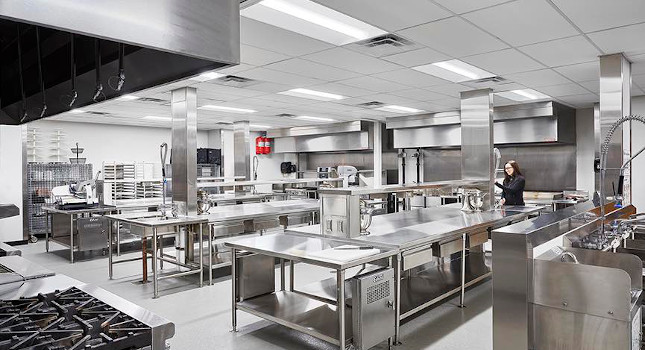With increasingly complex systems and technology coming into play, work on modern K-12 projects is anything but elementary

Respondents
Doug Everhart, Henderson Engineers
As a vice president and K-12 practice director, Everhart leads a team of education experts. With more than a decade of experience, his specialty involves designing innovative learning environments for students and teachers that use the spaces.
Anna Gradishar, Arup
As an Associate Fire Protection Engineer, Gradishar combines her fire protection and first responder backgrounds to offer expertise to owners, facility managers, tenants and design teams. She has developed comprehensive fire protection and life safety approaches for numerous building types and occupancies.
Keith Hammelman, CannonDesign
In his role as senior vice president, Hammelman focuses on the design and construction of pre-K-12 facilities, serving as the lead mechanical engineer for the firm’s central region. His sustainable project approach goes beyond the best mechanical system to the systemwide integration throughout an entire building.
David Lowrey, Boulder Fire Rescue
Lowrey has served with Boulder Fire Rescue for more than 20 years. He oversees the Community Risk Reduction Division, including code enforcement, building construction, life safety education and fire investigations.
Robert N. Roop, Peter Basso Associates
As principal and market leader for the company’s PBA’s K-12 Schools Group, Roop has spent more than half of his 32-year career exclusively designing educational facilities. He acts as the firm’s primary mechanical engineering technical resource for K-12 school projects.
Engiell Tomaj, Stantec
Tomaj first joined the company in 2012, first as associate, then promoted to principal and Business Center Discipline Leader. He holds an electrical engineering degree as well as an MBA.
Michael L. Younts, Dewberry
Serving as electrical engineer, Younts has been with the firm for more than 13 years. His expertise includes LEED projects, educational facilities and other areas.
CSE: Are there any issues unique to designing electrical/power systems for these types of facilities?
Tomaj: The latest issue we are facing for K-12 is backup power for storm shelters. With adoption of the 2015 IBC or later versions, this introduced the requirement for storm shelters for educational buildings. These storm shelters must be designed to ICC 500. In north Texas, we fall within the tornado zone and must design a storm shelter rated for an EF5 tornado with 250 mph winds. The shelter requires emergency backup power for 120 minutes for lighting and mechanical ventilation.
Younts: The transition to voice over internet protocol has changed the needs of emergency/standby systems in schools. Schools have multiple needs and are typically larger buildings where careful thought must go into the design of the emergency/standby systems. There is an increasing need for backup power in more areas so that the building can remain operational, especially in emergency situations. From project to project, the building configuration alone can significantly change these requirements solely based on the configuration of the key places that need backup power. Also, with more systems needing power over Ethernet connections, the need for backup power is growing.
Hammelman: We are seeing challenges with the design of plug load controls within K-12 facilities because this type of control system requires additional training of the staff within the facility, which goes beyond just maintenance personnel.
Gradishar: The electrical power distribution system is largely driven by programming functions of each space. Fully understanding the programming functions and provide a flexible design are the keys to allow end users to configure equipment layout to support their specific objectives.
CSE: What types of unusual standby, emergency or backup power systems have you specified for K-12 school buildings?
Gradishar: On the WS&S project, the emergency power generating apparatuses were existing to remain. A new emergency power distribution system was designed to meet national and local code requirements. Due to excessive generating capacity, the design team was able to configure a flexible distribution system to allow non-code mandated electrical loads to be connected to the emergency distribution system. As this is a boarding school with international students, providing means to keep students comfortable in an extended power outage was a design goal of the team. With automated emergency power management system in place, the nonessential building loads can be disconnected to ensure life safety, legally required standby and optional standby branches can be supported by the generators if total building loads are exceeded with generating capacity.
CSE: What kind of maintenance guidelines are involved to ensure the project is running efficiently after the project is finished?
Gradishar: It is imperative to design an energy efficient facility to provide occupant comfort and at same time keeping the maintenance cost at minimum. Single electrical distribution products were used by the construction team, so the owner does not have to stock different vendor’s spare parts. Long-lasting LED lamps were used to reduce replacement cycle.
CSE: What are some key differences in electrical, lighting and power systems you might incorporate in this kind of facility, compared to other projects?
Gradishar: Flexibility and room to grow are key system design parameters. For the WS&S project, increased spare capacity over the norm was provided at the branch circuit panelboard level to enable end users to add outlets to facilitate future programming requirements. Lighting circuits in the ceiling space has additional capacity to take on additional lighting loads if needed in the future without the need to pull new lighting circuits.
Younts: These systems must be designed with the intent that they be easily reconfigurable in the future. Decisions made in design have long-term effects on the success of future projects. For example, lighting controls can often be challenging, especially when integrating into the building automation system. The key is to establish what the owner wants early on. Designs that are code compliant can often not meet the needs of the client. What does the owner want, what are they looking for from a facility maintenance standpoint, what are their unique needs? The solution you used successfully for one school system may not be a success for another.
CSE: How does your team work with the architect, owner’s rep and other project team members so the electrical/power systems are flexible and sustainable?
Everhart: User-group meetings! And lots of them. We find that focused meetings with the specific teachers, administrators and students helps us properly plan the systems that will support equipment and specific uses. Every space is different. Early meetings are key with the proper stakeholders present.
Younts: Communication in the early phases of the project is essential to meet these goals. You need to establish what the owner’s plans are for now and in the future for the facility. Then you must decide what options/decisions make sense to pursue for the project. What can you do now to facilitate future changes within the current projects budget? Do you make the investment now or later?
Gradishar: Design team engagement with the architect and owner early on in a project to fully understand the end user’s programming space requirements is critical. It is best done as an iterative process of presenting a conceptual design to get end user’s feedback and revise the design to address end user’s input.
Tomaj: We are fortunate that we worked in a fully integrated firm and an interdisciplinary environment. Collaboration happens more naturally for us with our architects and this translates to better collaboration and teamwork with owners, owner’s reps, contractors, etc. What I continue to work on with my team is the Greek art of persuasion: ethos, pathos and logos. Often times engineers get caught up in jumping straight to logos (the logic behind their argument), because they feel they have the ethos (the credentials and experience). They miss most important step – pathos (empathy). I ask my team to spend time listening first. They must empathize with each member of the project team. Only once the professional is informed and fully understands the other stakeholders and the other stakeholders feels they are understood, can they proceed with the logos – the logic behind their argument. This makes for much better collaboration and developing solutions that are flexible and sustainable.
CSE: What kind of lighting designs have you incorporated into a K-12 school project, either for energy efficiency or to increase the occupant’s experience? Discuss the use of human-centric lighting or other lighting techniques.
Gradishar: On the Whittle School project in Washington, D.C., energy-efficient lighting fixtures coupled with an automated lighting control system were designed. Given the many benefits to people from exposure to natural lighting, daylight harvesting technology was used to minimize artificial lighting when natural lighting contribution can meet with desired lighting level in a space to improve occupant experience and save energy. The shapes of lighting fixtures in public spaces were carefully selected to ensure the aesthetics of the fixture blended into the architectural features of the interior to provide an overall pleasant visual effect for occupants.
Tomaj: Be wary of correlated color temperature. LED lighting tends to be a “cooler” white and often I’ve seen where a school district has old standards based on fluorescent lighting that require 5,000 Kelvin CCT. This tends to difficult to source for interior lighting and feels way too cool (blue) of a color, in my opinion. We tend to design around 3,500 Kelvin CCT. Work with your projects interior design to determine the best CCT for the materials and finishes being specified. We have started exploring tunable LED, where the CCT is adjustable throughout the day, however, this is currently being evaluated in our research and benchmarking program. There aren’t very many studies with good data for K-12 applications.
Everhart: Customizing lighting and flexible power systems specific to these space types are a key in proper design. For classrooms, our designs typically provide local manual/dimming control for lighting systems while also integrating automatic daylight harvesting and occupancy sensor automatic shut-off. Lighting zones are dimmed for different modes of the classroom — audiovisual mode, energy savings mode, test taking mode, etc. In most projects we are designing 100% LED-based systems. LED allows for better efficiency, longer life and enhanced controllability.
CSE: When designing lighting systems for these types of structures, what design factors are being requested? Are there any particular technical advantages that are or need to be considered?
Gradishar: On the Whittle School project in Washington, D.C., high color rendering index lighting sources were requested to bring out true color.
Tomaj: The No. 1 request I receive is to design an easily maintainable lighting system. This includes limiting the quantity of different fixture types, locating fixtures where they accessible without major equipment or scaffolding, selecting fixtures with appropriate durability for the environment in which they are installed, among others.



